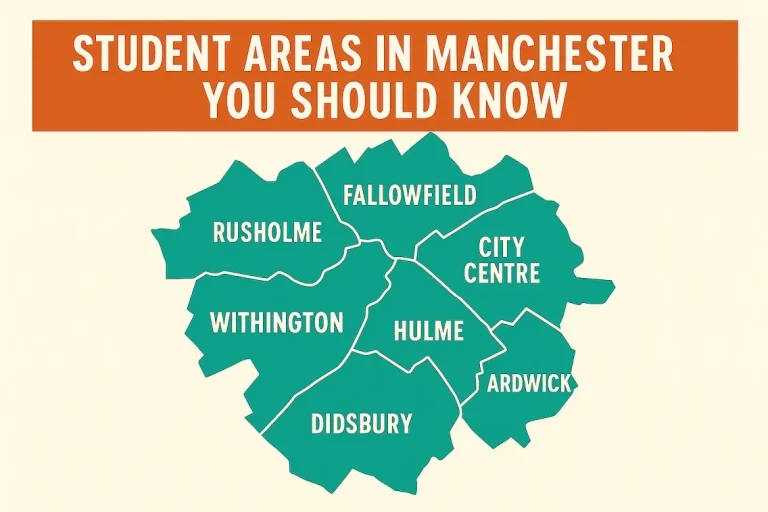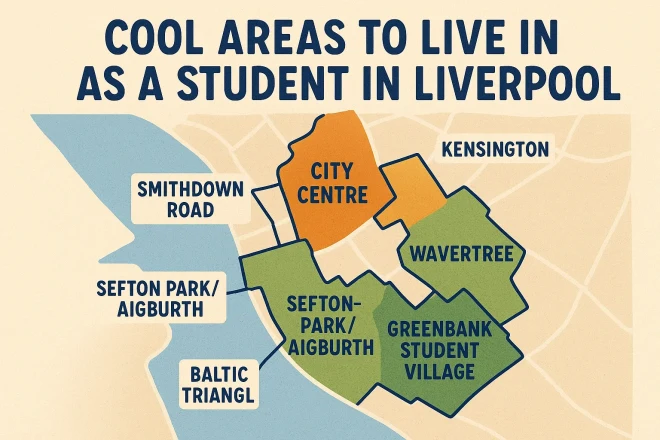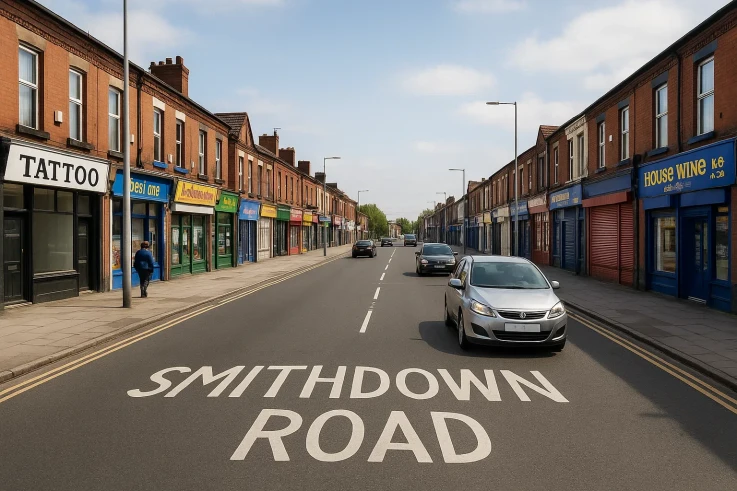Well, Well, since you are here we guess ‘congratulations’ are in order. As a student coming to Manchester for studies, there are so many things to understand. Isn’t it? After finalizing the university, the next thing one should do is to figure out where to live in Manchester. And, if you are worried for this, don’t be as Uninist has got your back. From long-term to short-term student accommodation in Manchester, there are many student areas to explore.
Manchester has been one of the most popular cities in the UK for students. From attracting thousands of students to offering diversity, this city brings a lively culture, affordable lifestyle, and mesmerizing nightlife. However, that’s not what we are going to discuss today. This particular blog revolves around the best student areas in Manchester to consider while you are searching for your next home. So, keep on reading man as we have got you what others could not. Whether it is about exploring or knowing pros and cons, you will find everything below.
Factors to Consider While Choosing the Student Area in Manchester
Before coming to the main agenda of this blog, let’s discuss what should be in your mind while exploring student areas in Manchester. Here are the things you should consider while looking for student housing:
- Budget: The first thing when you are searching for an area is the budget and how much you are willing to spend. If you are looking for affordable housing in Manchester then areas like Rusholme, Ardwick, and Withington are great choices. However, if you are someone who is comfortable with spending a little more on housing then go for areas like the city centre, and Didsbury.
- Commute to University: Students at University of Manchester or MMU might prefer Rusholme, Hulme, or Ardwick due to their closeness. For students at University of Salford areas like Salford Quays or city centre are more practical choices. After all, you must know why transit matters near student accommodation in UK.
- Lifestyle Preference: If budget and college is not in the picture and you are searching for a student property in Manchester on the basis of your lifestyle then go to Fallowfield or City Centre if you are fond of nightlife and socializing. Looking for a quiet and peaceful environment then Didsbury or Victoria park is your spot. Plus, when you are looking for a balance of both then Withington or Hulme is your destination.
- Safety: Apart from all things, a basic human need is safety and Manchester is generally student friendly, but safety varies by neighborhood. Places like Didsbury and Withington are considered very safe, while Fallowfield, though lively, has more incidents due to a very large number of student population, but overall Manchester is a very safe city with great law and order.
The Best Student Areas to Live in Manchester
Now, it’s time to get to the main topic of this blog. Here are the top areas which are perfect for students in Manchester:
- Fallowfield
- Rusholme
- Withington
- City Centre
- Hulme
- Didsbury
- Ardwick
Fallowfield
- Suitable for: Fallowfield has been considered as the student hub of Manchester because of its high student population. With one of the largest concentrations of student accommodation in UK, you will find options ranging from university halls to private rentals. This area is suitable for students because of the high population of students and also the atmosphere is vibrant with many pubs, takeaways, and engaging nightlife.
- Pros: The pros of living in Fallowfield is that it has a close-knit student community making it very easy to meet new people. Plus, you will find affordable housing compared to the city centre. The nightlife is also amazing and direct bus routes to both University of Manchester and Manchester Metropolitan University.
- Cons: The cons of living in this area is that it is very noisy because of constant late-night student activities. Fallowfield is a little far from the city centre, about 20-25 minutes away from the bus. Also, a major drawback here is that it is reported as less safe compared to other quieter areas.
Rusholme
- Suitable For: Rusholme is located near to Fallowfield and the area is famous for Curry Mile. This area is suitable for students who are searching for student properties in Manchester at an affordable rate. Many students prefer to live here because of budget-friendly food and diverse cultural vibe.
- Pros: The pros of living in this area as a student are that this area has a variety of cheap food outlets and is perfect for students who are on a budget. This area is close to both University of Manchester and MMU and has an affordable rent compared to central Manchester.
- Cons: The cons of this area is that the area faces high traffic because of Curry Mile’s popularity. The nightlife is also very limited and you will need to visit Fallowfield or the city centre for parties and some areas may feel congested and crowded.
Withington
- Suitable For: If you love a quiet environment then Withington is for you, it is like a quieter alternative to Fallowfield while the area is also student-friendly. As one of the prime tips for international students in UK, consider living here to experience balance between peace and social life.
- Pros: The pros of this area are that it is more laid-back compared to Fallowfield, but still very student-centric. The area has trendy coffee shops, vintage stores, and indie bars. Also, the area has cheaper housing options compared to the city centre and has a well connected system of bus routes to the universities.
- Cons: The cons of living in this area are that it is not as lively as Fallowfield for those who crave constant nightlife. Withington is slightly further from Universities than Rusholme.
City Centre
- Suitable For: City centre is always the best part of the city. As the heart of Manchester, this area is perfect for students who like to live in the heart of the city. Living in the centre means everything is within your reach. From the best clubs in Manchester to universities, this area has it for students.
- Pros: The pros of living in the city centre are that the transport connection is excellent with trams, buses, and trains. The universities are also within walking distance like the University of Manchester and MMU campus is very close. Also, the access to high-end amenities like shopping centers, nightlife, and restaurants is very easy.
- Cons: The cons of living in the city centre is that it is very expensive compared to other student areas and can get very noisy and busy which is not ideal for students who love a peaceful and calm environment.
Hulme
- Suitable For: Hulme is suitable for students who want cheaper rent and also don’t want to be far from universities. This area is getting popularity for its proximity to universities and cheaper rent.
- Pros: The pros of living in Hulme is that it is a short walk or bus ride away from University of Manchester and has more affordable apartments than the city centre. Also, local amenities and famous supermarkets in UK are very close.
- Cons: The cons of living in this area is that it is not as lively as Fallowfield or the city centre and the scope of student events and bars are also very low.
Didsbury
- Suitable For: Didsbury is perfect for students who like to live in residential areas, filled with greenery, and relaxed vibes. The student area is popular among final-year and postgraduates.
- Pros: The pros of living in this area is that it is filled with green surroundings and parks for a calmer and peaceful environment, has trendy cafes, bars, and restaurants. Also, this area is very safe and has a friendly atmosphere.
- Cons: The cons of living here is that the area is far from universities like it has a 20-25 minutes of bus ride just to reach the university. The area also has higher rent compared to other student areas like Withington or Rusholme. It is also not that “student populated” so, you will feel a little disconnected from the student nightlife.
Ardwick
- Suitable For: This area is perfect for students who are looking for affordable student accom in Manchester and wants to be not that far from the University of Manchester. Also, Ardwick is not that far from the city centre and you can reach there very easily.
- Pros: The University of Manchester is within walking distance, the rent is cheaper than the city centre, and also has a great bus connection.
- Cons: The cons are that this area has a limited nightlife and amenities and it is less vibrant than student focused areas like Fallowfield.
Conclusion
As you know Manchester has been a city that offers several student-friendly neighborhoods. With its own unique lifestyle, areas are different yet so friendly. Some are more student focused some are less, some are affordable some are expensive, but each area of Manchester has something of its own to offer.
Whether you experience a buzzing social life in Fallowfield or spend a peaceful day in the greenery of Didsbury, there is no end to new experiences. No matter where you live just make sure it is close to your university and under your budget with the lifestyle you want. So, find your dream student accommodation in Manchester with Uninist today!
FAQ
Where can students find student accommodation in Manchester?
Manchester has many areas where you can find suitable student areas. Here are some of the top areas to explore that are worth living in Manchester:
1. Fallowfield
2. Rusholme
3. Withington
4. City Centre
5. Hulme
6. Didsbury
7. Ardwick
8. Victoria Park
Which area is cheaper in Manchester: City Centre or Fallowfield?
Both the areas are good for students, but obviously one is cheaper and one is more expensive. Fallowfield is way cheaper that City centre and more affordable for students as the area is student-friendly and highly populated by students.
Which area of Manchester has the best nightlife for students?
The area which has the best nightlife for students is Fallowfield because it is highly populated by students and consists of various student-friendly spots like bars, pubs, and clubs. The city centre of Manchester also has a high scope of nightlife, so both the areas are good for nightlife for students.
Which area in Manchester is filled with greenery?
If you are someone who likes greenery and want to live in an area which has high greenery then look for a student accommodation in Didsbury as the area is filled with greenery. Also, Didsbury is a residential area so it offers a quiet and peaceful environment as well perfect for students.













![Tata Scholarship: A Comprehensive Guide for Students 2025 [Updated] Tata Scholarship: A Comprehensive Guide for Students 2025 [Updated]](https://uninist.com/blog/wp-content/uploads/2025/08/tatascholarship-768x512.webp)

